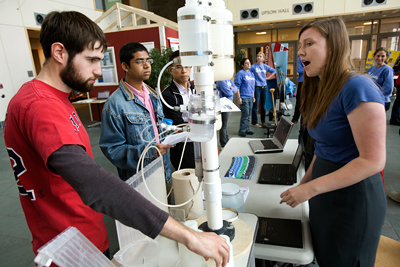Cornell students demonstrated their robotic development skills at the undergraduate research programme conducted by the College of Engineering at the Duffield Hall on 17 September.
 Members of AguaClara explain water filtration during the engineering showcase in Duffield Hall.
Members of AguaClara explain water filtration during the engineering showcase in Duffield Hall.
One of the projects that were displayed was from the Cornell Racing Team, which takes part in championships build a formula racing car every year. Another team called the ChemE Car team were involved in building cars that were powered by chemicals reacting with each other and the size of the cars was the size of a shoe box. Zoidberg, a car powered by the chemical combination of zinc-carbon, was a winner in the 2010 championship. This year the team is building Zoidberg II which is powered by an alkaline battery.
The Steel Bridge Team works on using computer-aided design to build a bridge which is capable of bearing a weight of 1,500 pounds. Another team built nano-satellites that measured 3 ft in length and had a weight that was less than 110 lbs; this satellite was the winner of the University Nanosat-4 program sponsored by U.S Air Force. Another creation by this team is Violet, which is a nano-satellite that is based on gyroscopic steering. The Cornell Mars Rover Team built rovers that were capable of navigating through rugged surfaces and while traversing through the terrain collected soil samples and dropped packages. One of the team members pointed out that they used aluminium for the body and plastic for the arms of the rover in order to restrict the weight and cost to the minimum.
The Human Flight Project team have built a remote controlled aircraft which runs on electrical connections and is capable of carrying a payload of 3.75 lbs. The aircraft is capable of flying through a circular path and ascending a height of 100 m. The CUAir team built an unmanned automatic aircraft which could be used in surveillance missions since it was capable of using GPS to locate itself and track the targets with the help of a DLSR camera mounted on its gimbals. Finally the Cornell Baja Racing team have come up with innovatively designed vehicles which could compete on off-road tracks.